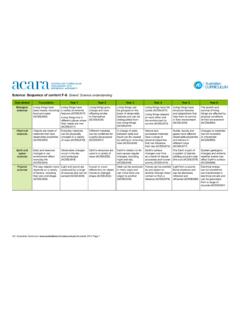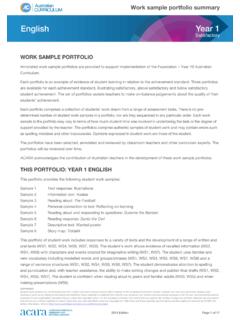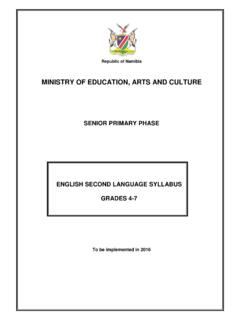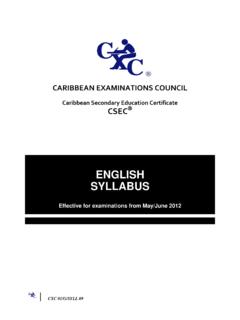Transcription of ontent for ear Learning area content descritions English
1 content for Year 2 - Learning area content descriptionsEnglishLANGUAGEL anguage variation and changeUnderstand that spoken, visual and written forms of language are different modes of communication with different features and their use varies according to the audience, purpose, context and cultural background (ACELA1460) language for social interactionsUnderstand that language varies when people take on different roles in social and classroom interactions and how the use of key interpersonal language resources varies depending on context (ACELA1461)Evaluative languageIdentify language that can be used for appreciating texts and the qualities of people and things (ACELA1462)Purpose audience and structures of different types of textsUnderstand that different types of texts have identifiable text structures and language features that help the text serve its purpose (ACELA1463)Text cohesionUnderstand how texts are made cohesive through language features, including word associations, synonyms, and antonyms (ACELA1464)PunctuationRecognise that capital letters signal proper nouns and commas are used to separate items in lists (ACELA1465)Concepts of print and screenKnow some features of text organisation including page and screen layouts, alphabetical order, and different types of diagrams, for example timelines (ACELA1466)
2 Sentences and clause-level grammarUnderstand that simple connections can be made between ideas by using a compound sentence with two or more clauses usually linked by a coordinating conjunction (ACELA1467)Word-level grammarUnderstand that nouns represent people, places, concrete objects and abstract concepts; that there are three types of nouns: common, proper and pronouns; and that noun groups/phrases can be expanded using articles and adjectives (ACELA1468)Visual languageIdentify visual representations of characters actions, reactions, speech and thought processes in narratives, and consider how these images add to or contradict or multiply the meaning of accompanying words (ACELA1469)VocabularyUnderstand the use of vocabulary about familiar and new topics and experiment with and begin to make conscious choices of vocabulary to suit audience and purpose (ACELA1470)
3 Phonological and phonemic awarenessOrally manipulate more complex sounds in spoken words through knowledge of blending and segmenting sounds, phoneme deletion and substitution in combination with use of letters in reading and writing (ACELA1474)Alphabet and phonic knowledgeUse most letter-sound matches including vowel digraphs, less common long vowel patterns, letter clusters and silent letters when reading and writing words of one or more syllable (ACELA1824)Understand that a sound can be represented by various letter combinations (ACELA1825)SpellingUnderstand how to use knowledge of digraphs, long vowels, blends and silent letters to spell one and two syllable words including some compound words (ACELA1471) Use knowledge of letter patterns and morphemes to read and write high-frequency words and words whose spelling is not predictable from their sounds (ACELA1823) Build morphemic word families using knowledge of prefixes and suffixes (ACELA1472)LiTErATUrEHow texts reflect the context of culture and situation in which they are created Discuss how depictions of characters in print, sound and images reflect the contexts in which they were created (ACELT1587)Personal responses to the ideas, characters and viewpoints in textsCompare opinions about characters, events and settings in and between texts (ACELT1589)
4 Expressing preferences and evaluating textsIdentify aspects of different types of literary texts that entertain, and give reasons for personal preferences (ACELT1590)Features of literary textsDiscuss the characters and settings of different texts and explore how language is used to present these features in different ways (ACELA1591) language devices in literary texts, including figurative languageIdentify, reproduce and experiment with rhythmic, sound and word patterns in poems, chants, rhymes and songs (ACELT1592)Creating literary textsCreate events and characters using different media that develop key events and characters from literary texts (ACELT1593)Experimentation and adaptationInnovate on familiar texts by experimenting with character, setting or plot (ACELT1833)LiTErACyTexts and the contexts in which they are usedDiscuss different texts on a similar topic, identifying similarities and differences between the texts (ACELY1665)Listening and speaking interactionsListen for specific purposes and information, including instructions, and extend students own and others ideas in discussions (ACELY1666)Listening and speaking interactionsUse interaction skills including initiating topics, making positive statements and voicing disagreement in an appropriate manner, speaking clearly and varying tone, volume and pace appropriately (ACELY1789)
5 Oral presentationsRehearse and deliver short presentations on familiar and new topics (ACELY1667)Purpose and audienceIdentify the audience of imaginative, informative and persuasive texts (ACELY1668)reading processesRead less predictable texts with phrasing and fluency by combining contextual, semantic, grammatical and phonic knowledge using text processing strategies, for example monitoring meaning, predicting, rereading and self-correcting (ACELY1669)Comprehension strategiesUse comprehension strategies to build literal and inferred meaning and begin to analyse texts by drawing on growing knowledge of context, language and visual features and print and multimodal text structures (ACELY1670)Creating textsCreate short imaginative, informative and persuasive texts using growing knowledge of text structures and language features for familiar and some less familiar audiences, selecting print and multimodal elements appropriate to the audience and purpose (ACELY1671)EditingRe-read and edit text for spelling, sentence-boundary punctuation and text structure (ACELY1672)HandwritingWrite legibly and with growing fluency using unjoined upper case and lower case letters (ACELY1673)Use of software Construct texts featuring print, visual and audio elements using software, including word processing programs (ACELY1674)
6 Australian Curriculum December 2015 Page 1 content for Year 2 - Learning area content Australian Curriculum December 2015 Page 2 MathematicsProficiency StrandsUnderstanding Includes using generalising from number properties and results of calculations, comparing angles and creating and interpreting variations in the results of data collections and data displaysFluencyIncludes readily counting numbers in sequences, using informal units iteratively to compare measurements, using the language of chance to describe outcomes of familiar chance events and describing and comparing time durationsProblem SolvingIncludes formulating problems from authentic situations, making models and using number sentences that represent problem situations, and matching transformations with their original shapereasoningIncludes using known facts to derive strategies for unfamiliar calculations, comparing and contrasting related models of operations and creating and interpreting simple representations of proficiency strands describe the actions in which students can engage when Learning and using the content .
7 While not all proficiency strands apply to every content description, they indicate the breadth of mathematical actions that teachers can AND ALGEBrANumber and place value Investigate number sequences, initially those increasing and decreasing by twos, threes, fives and tens from any starting point, then moving to other sequences (ACMNA026)Recognise, model, represent and order numbers to at least 1000 (ACMNA027)Group, partition and rearrange collections up to 1000 in hundreds, tens and ones to facilitate more efficient counting (ACMNA028)Explore the connection between addition and subtraction (ACMNA029)Solve simple addition and subtraction problems using a range of efficient mental and written strategies (ACMNA030)Recognise and represent multiplication as repeated addition, groups and arrays (ACMNA031)Recognise and represent division as grouping into equal sets and solve simple problems using these representations (ACMNA032)Fractions and decimalsRecognise and interpret common uses of halves, quarters and eighths of shapes and collections (ACMNA033)Money and financial mathematicsCount and order small collections of Australian coins and notes according to their value (ACMNA034)Patterns and algebraDescribe patterns with numbers and identify missing elements (ACMNA035)Solve problems by using number sentences for addition or subtraction (ACMNA036)
8 MEASUrEMENT AND GEOMETryUsing units of measurementCompare and order several shapes and objects based on length, area , volume and capacity using appropriate uniform informal units (ACMMG037)Tell time to the quarter-hour, using the language of past and to (ACMMG039)Name and order months and seasons (ACMMG040)Use a calendar to identify the date and determine the number of days in each month (ACMMG041)Compare masses of objects using balance scales (ACMMG038)ShapeDescribe and draw two-dimensional shapes, with and without digital technologies (ACMMG042)Describe the features of three-dimensional objects (ACMMG043)Location and transformationInterpret simple maps of familiar locations and identify the relative positions of key features (ACMMG044)Investigate the effect of one-step slides and flips with and without digital technologies (ACMMG045)Identify and describe half and quarter turns (ACMMG046)STATiSTiCS AND PrOBABiLiTyChanceIdentify practical activities and everyday events that involve chance.
9 Describe outcomes as likely or unlikely and identify some events as certain or impossible (ACMSP047)Data representation and interpretationIdentify a question of interest based on one categorical variable. Gather data relevant to the question (ACMSP048)Collect, check and classify data (ACMSP049)Create displays of data using lists, table and picture graphs and interpret them (ACMSP050)ScienceSCiENCE UNDErSTANDiNGBiological sciencesLiving things grow, change and have offspring similar to themselves (ACSSU030)Chemical sciencesDifferent materials can be combined for a particular purpose (ACSSU031)Earth and space sciencesEarth s resources are used in a variety of ways (ACSSU032)Physical sciencesA push or a pull affects how an object moves or changes shape (ACSSU033)SCiENCE AS A HUMAN ENDEAVOUry 1-2 Nature and development of scienceScience involves observing, asking questions about, and describing changes in, objects and events (ACSHE034)
10 Use and influence of sciencePeople use science in their daily lives, including when caring for their environment and living things (ACSHE035)SCiENCE iNqUiry SkiLLSy 1-2questioning and predictingPose and respond to questions, and make predictions about familiar objects and events (ACSIS037)Planning and conductingParticipate in guided investigations to explore and answer questions (ACSIS038)Use informal measurements to collect and record observations, using digital technologies as appropriate (ACSIS039)Processing and analysing data and inf











